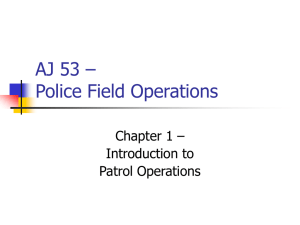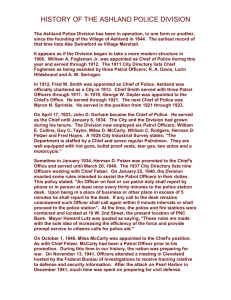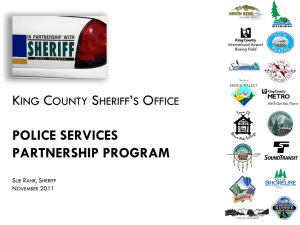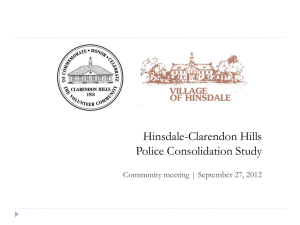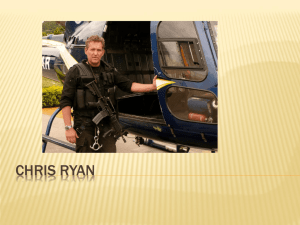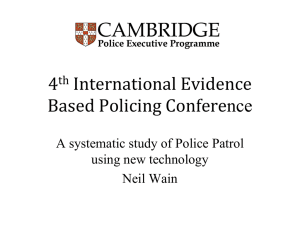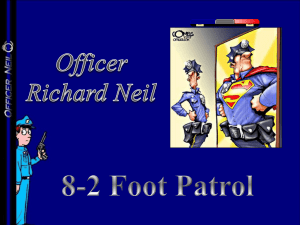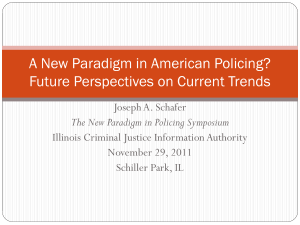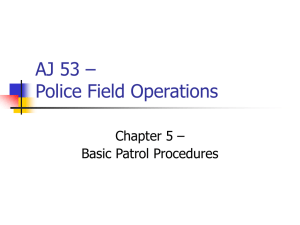Chapter 6 – Policing: Roles, Styles, and Functions
advertisement
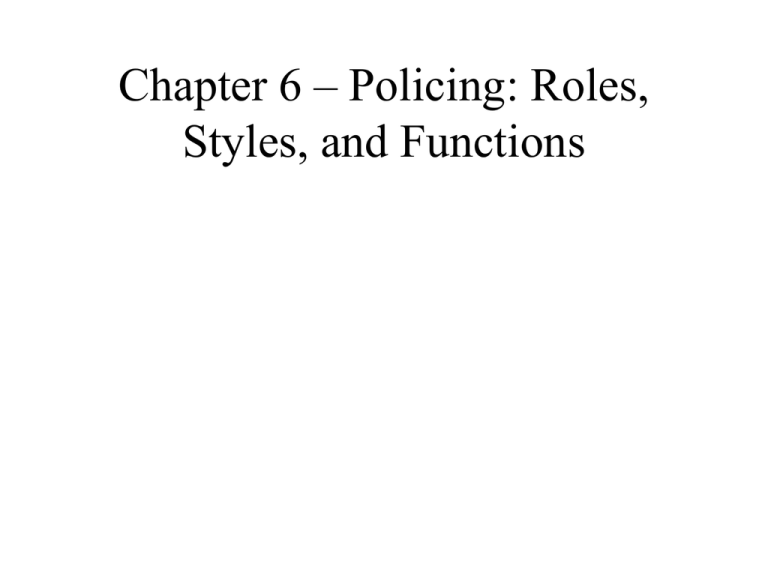
Chapter 6 – Policing: Roles, Styles, and Functions The Roles of the Police • What Americans expect from the police depends on how we view their role in society. • Different people have different role expectations for the local police. • When the public’s expectation’s differ from the official police role, officers may suffer role conflict. The Roles of the Police Not everyone views the role of the police in the same way. The majority of perspectives consider that the police: 1. are community leaders in public safety. 2. possess broad discretion. 3. solve sociological and technological problems for people on a short-term basis. 4. occasionally serve in a hostile or dangerous environment. Characteristics of Police Work Police work requires a combination of special characteristics. Police work involves: • Quick decision-making • Working independently • “Dirty work” • Danger Operational Styles After police officers are trained and begin to gain experience, it is believed they develop operational styles. Operational Styles One of the earliest scholars to report on the existence of policing styles was James Q. Wilson. He found three styles: • Legalistic: an emphasis on violations of law, and the use of threats or actual arrests to solve disputes. • Watchman: an emphasis on informal means of resolving disputes. continued… Operational Styles • Service: an emphasis on helping the community, as opposed to enforcing the law. Operational Styles A number of other scholars have tried to categorize policing styles. In practice, it is difficult to categorize police officers, because each officer reacts differently depending on the situation. Police Functions The list of functions that police are expected to carry out is long and varies from place to place. There are some similarities in police departments though. Patrol Patrol is called the backbone of the department by administrators. It is the most time-consuming and resource-intensive task officers undertake. Patrol Patrol duties include: • Responding to burglar alarms • Investigating traffic accidents • Caring for injured people • Trying to resolve domestic disputes • Responding to radio calls Preventive Patrol Traditionally, police officers use the time between radio calls to participate in preventive patrol. In the 1960s, people began to question the usefulness of preventive patrol. Directed Patrol • Another strategy is directed patrol. Evidence shows directed patrol can reduce the incidence of targeted crimes such as thefts from autos and robberies. • Directed patrol can be aided by crime mapping. Aggressive Patrol • A strategy that can result in arrests for both minor and serious offenses is aggressive patrol. • This strategy has drawbacks: Innocent citizen are inconvenienced by random traffic stops and field interrogations. It is often difficult to get all officers motivated to use aggressive tactics. Foot Patrol The practice of having officers patrol their beats on foot has regained popularity recently. While foot patrols have not been proven to be a significant deterrent to crime, they have significantly improved relationships between citizens and officers. Investigation Detectives may be the most glorified police officers, but they are only one unit. There are many forms of investigation in any police department, from hit-and-run accidents, to undercover vice investigations, to background checks on potential police officers. What is Criminal Investigation? Criminal investigation has been defined as a lawful search for people and things to reconstruct the circumstances of an illegal act, apprehend or determine the guilty party, and aid in the state’s prosecution of the offender. What is Criminal Investigation? The criminal investigation process has two parts: • Preliminary investigation: usually by patrol officers (except in the case of homicide, or other complex investigations). • Follow-up investigation: usually by plainclothes detectives. Investigative Functions In any type of investigation, investigators must: • • • • Locate witnesses and suspects Arrest criminals Collect, preserve, and analyze evidence Interview witnesses continued… Investigative Functions • • • • • Interrogate suspects Write reports Recover stolen property Seize contraband Prepare cases and testify in court The Role of the Detective Detectives enjoy several advantages over patrol officers: • They do not have to wear uniforms. • They have anonymity during work hours if they choose it. • They have steady work hours, often during daytime hours with weekends off. • They have offices and desks. continued… The Role of the Detective • They enjoy the prestige associated with the position. • In many agencies, detectives receive higher compensation and hold a higher rank. • They have more freedom than patrol officers. Productivity Despite the advantages, detectives often face insurmountable obstacles and stressful work conditions: • Crimes can be very difficult to solve. • Witnesses who could help often don’t want to get involved. • Even with hard work, the success rate can be very low. Traffic Each year, nearly twice as many people are killed in automobile accidents on the streets and highways of America as are murdered. • Many deaths are alcohol-related. • Traffic enforcement and accident investigation is so important some agencies have traffic accident investigation crews. Community Policing Recently, the effectiveness of the professional model of policing has been questioned: • Preventive patrol • Quick response • Follow-up investigation Was shown not to reduce the incidence of crime. Rarely leads to quick arrest. Is not as important as the investigation done by the officer on the scene. Community Policing The “broken windows” theory states that those minor annoyances are “signs of crime” and that if they are not dealt with early, more serious problems are likely to occur. The Philosophy and Components of Community Policing With community policing, citizens share responsibility for their community’s safety. The Philosophy and Components of Community Policing Citizens and the police work collectively to: • Identify problems • Propose solutions • Implement actions • Evaluate the results Community Partnership The first component of community policing is establishing and maintaining mutual trust between citizens of a community and the police. Problem Solving For problem solving to work effectively, the police need to devote time and attention to discovering a community’s concerns, and they need to recognize the validity of those concerns. Community Partnership Building police-community partnerships involves: • Talking to local business owners • Visiting residents in their homes • Supporting neighborhood watch groups • Ongoing communication with residents Problem Solving In community policing, a four-step process known as SARA is often used: • Scanning—identifying problems • Analysis—understanding underlying problems • Response—developing and implementing solutions • Assessment—determining the solutions’ effect Change Management Community policing requires: • Flexible management styles • An emphasis on the value of patrol officers • Shifting decision-making and responsibility downward in the chain of command • Patrol officers having the resources to solve the community’s problems Implementing Community Policing Successful implementation of community policing requires that both the community and law enforcement understand the underlying philosophy and have a true commitment to the community policing strategy.

